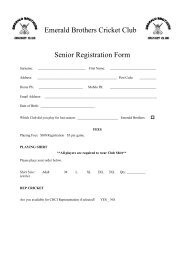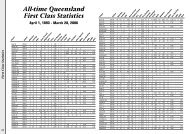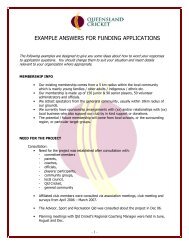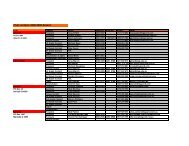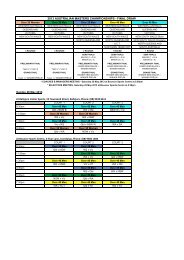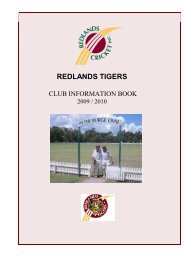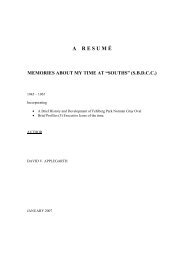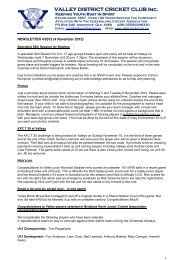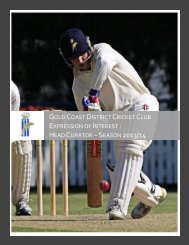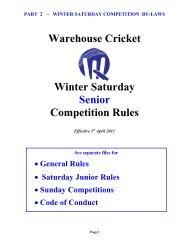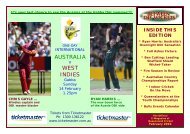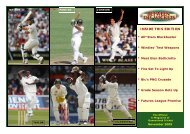-16-1946-1968 JACK MCLAUGHLININTRODUCTIONWhen World War II finished on 25 August 1945, a new era in <strong>the</strong> <strong>history</strong> <strong>of</strong> Western Suburbs CricketClub was born.Some <strong>club</strong> members lost <strong>the</strong>ir lives in <strong>the</strong> war, o<strong>the</strong>rs had promising <strong>cricket</strong> careers interrupted butthankfully returned. Two <strong>of</strong> <strong>the</strong>se were Bob Stafford and Ern Toovey who survived <strong>the</strong> privations <strong>of</strong>Japanese Prisoner <strong>of</strong> War Camps.The American Artillery unit stationed on <strong>the</strong> No. 2 oval returned home to <strong>the</strong> States. Graceville Oval andWests returned to <strong>the</strong>ir former glory. The No.1 Oval looked resplendent with its white picket fence, <strong>the</strong>grandstand was filled with paying spectators for Saturday <strong>cricket</strong>, a turf pitch graced <strong>the</strong> No.3 oval, turfpractice wickets stood in front <strong>of</strong> <strong>the</strong> sight screen on No.1 oval and <strong>the</strong> pitches and playing surfaceregained its reputation <strong>of</strong> being <strong>the</strong> best in Brisbane.Cricket was back at Western Suburbs District Cricket Club.The motto for Wests at <strong>the</strong> time was not “I play with Western Suburbs” but “How well do I play forWestern Suburbs”.When <strong>the</strong> Intermediate Grade was introduced into <strong>the</strong> competition <strong>the</strong> committee likened it to a “SavingsBank” where <strong>the</strong> boys were <strong>the</strong> “<strong>club</strong>’s deposits”. If treasured carefully <strong>the</strong>se “Deposits” with <strong>the</strong>ir“Accumulated Interest” should in later years provide <strong>the</strong> <strong>club</strong> with a “Reserve Fund” which should protectit against “Player Insolvency”.A review <strong>of</strong> <strong>the</strong> records during this period bears testimony to <strong>the</strong> investment made.There is no doubt that <strong>the</strong> period under review was a “Golden Era” in <strong>the</strong> <strong>history</strong> <strong>of</strong> <strong>the</strong> <strong>club</strong>: between1945-6 and 1970-1 seasons.! 3 players were chosen in Australian teams! 3 players Captained <strong>the</strong> state! 22 players gained Interstate Representation! The A Grade competition was won on five occasions! The lower grades won 13 premierships! Wests won <strong>the</strong> Club Championship three times and finished no lower than third on nineoccasions.These great statistics could not have been obtained without <strong>the</strong> preparedness <strong>of</strong> older players droppingdown to <strong>the</strong> lower grades to nurture <strong>the</strong> development <strong>of</strong> our youngsters and <strong>the</strong> depth <strong>of</strong> quality playersthroughout <strong>the</strong> <strong>club</strong>.I trust this <strong>history</strong> which I have conveyed to <strong>the</strong> <strong>club</strong> gives <strong>the</strong> members some sense <strong>of</strong> pride that it hasgiven me as I relive <strong>the</strong> many matches and happy memories that only <strong>cricket</strong> can provide.Any omissions are unintentional for which I apologise.WESTERN SUBURBS - THE FAMILY CLUBThe years following World War II became known as <strong>the</strong> “Baby Boomer” years.Families were being reunited, money was not that plentiful, television was still years away in Australia,<strong>the</strong>re were no fast food outlets and shops did not trade after midday on Saturday. As a consequencefamilies had time to be associated with <strong>the</strong> <strong>club</strong>.Dad would be on <strong>the</strong> executive, or playing in <strong>the</strong> lower grades, mum would be helping in <strong>the</strong> refreshmentstall, junior would be playing in <strong>the</strong> Intermediate or Schoolboy Grade and our grandfa<strong>the</strong>r would be anassociated member <strong>of</strong> <strong>the</strong> <strong>club</strong> occupying his seat in <strong>the</strong> grandstand with his mates giving criticalcomment and praise on <strong>the</strong> players’ performances.Help and support was always available to players and families who were experiencing tragedy orpersonal difficulties.The following are some families associated with <strong>the</strong> <strong>club</strong> at that time:Freeman’s - George (fa<strong>the</strong>r and Hon Secretary), John and David. The Freeman Family providedaccommodation to Ray Reynolds and <strong>the</strong> Trimble boys.Shaw’s - Bert (fa<strong>the</strong>r and Hon Secretary), Hugh, Rog and Ken.Westaway’s - Ted (fa<strong>the</strong>r), John, Les and Colin.Arthy’s - Cliff (fa<strong>the</strong>r), Ted, Keith and Barry.McLaughlin’s - Red (fa<strong>the</strong>r), Jack, Pat and Michael.Draney’s - George (Asst Secretary), Neville and Alan.Draney’s - Pop (fa<strong>the</strong>r), John and Bill.Kricker’s - Cyril (fa<strong>the</strong>r and Treasurer), Les and Ge<strong>of</strong>f.McCasker’s - Les (fa<strong>the</strong>r and manager schoolboy teams), Ross and Kim.No doubt <strong>the</strong>re are many o<strong>the</strong>rs who deserve recognition but memory does not enable me to recall <strong>the</strong>m.Please accept my apologies for <strong>the</strong>ir omission.GRACEVILLE OVALSMany <strong>cricket</strong>ers are prone to complain about <strong>the</strong> state <strong>of</strong> <strong>the</strong> pitch or <strong>the</strong> surrounding areas for <strong>the</strong>paucity <strong>of</strong> <strong>the</strong>ir performances. The only answer to this is to give <strong>the</strong>m a hose and roller on a Mondaymorning and ask <strong>the</strong>m to prepare <strong>the</strong> grounds for next Saturday’s match. Then only will <strong>the</strong>y realise <strong>the</strong>difficulty facing our groundsmen in <strong>the</strong>ir effort to provide a stage where <strong>the</strong>y can act <strong>the</strong>ir part.Western Suburbs <strong>cricket</strong>ers have been fortunate over <strong>the</strong> years that <strong>the</strong> men holding <strong>the</strong> hose andpushing <strong>the</strong> roller have provided <strong>the</strong>m with what is recognised as one <strong>of</strong> <strong>the</strong> best playing surfaces inBrisbane.Things changed in this era. The turf pitch was replaced with a syn<strong>the</strong>tic surface and <strong>the</strong> dressing shedhas been removed from <strong>the</strong> No.3 oval. The wicket on <strong>the</strong> No.2 oval was relocated fur<strong>the</strong>r to <strong>the</strong> north..The picket fence and turf practice wickets on <strong>the</strong> No.1 oval were no longer <strong>the</strong>re. Syn<strong>the</strong>tic practicewickets and nets replaced <strong>the</strong>m on <strong>the</strong> west <strong>of</strong> <strong>the</strong> grandstand.
-17-Early wickets prepared by Jack McAndrew Snr and John Norris were done with <strong>the</strong> assistance <strong>of</strong> a horsedrawn roller and shone like a new shilling. Death was <strong>the</strong> penalty for anyone playing on <strong>the</strong>m in rubbersoled shoes. So keen was Jack McAndrew on his job, he would finish preparing <strong>the</strong> pitches at 11.00amon match day, return home to Goodna for lunch and <strong>the</strong>n come back to <strong>the</strong> oval to seek a report from<strong>the</strong> players on how <strong>the</strong> pitch played. There were no covered pitches in those days.Keenness and love <strong>of</strong> <strong>the</strong> game continued throughout <strong>the</strong> years by <strong>the</strong> groundsmen who followed in <strong>the</strong>irsteps except with more modern day machinery. We acknowledge and thank <strong>the</strong>se men whose effortsupheld our reputation - Jack McAndrew (Jnr), Bill Hodgson, Vic Wells, Matt Forster, Owen Driscoll andJohn Draney.The Graceville Oval has a rare place in <strong>the</strong> <strong>district</strong>’s <strong>history</strong> and Wests has been entrusted to uphold itstradition.COMMUNICATIONCommunication within <strong>the</strong> <strong>club</strong> was difficult after <strong>the</strong> war and as a consequence players were notified <strong>of</strong><strong>the</strong>ir selection through <strong>the</strong> post. Selection meetings were held on Monday night and <strong>the</strong> teams wereposted out on Tuesday if possible. People having a telephone were as rare as hen’s teeth.Copy <strong>of</strong> Notification (O. Driscoll) - see next pagePractice was held on Tuesday and Thursday afternoons on <strong>the</strong> three turf practice wickets located in front<strong>of</strong> <strong>the</strong> sight screen at <strong>the</strong> sou<strong>the</strong>rn end <strong>of</strong> <strong>the</strong> grounds. It would commence when Ge<strong>of</strong>f Cook got <strong>the</strong>reat about 3.00pm and any available schoolboys would bowl to him for no less than half an hour. On <strong>the</strong>arrival <strong>of</strong> o<strong>the</strong>r players he would <strong>the</strong>n have his 15 minutes practice against <strong>the</strong>m. Practice ceased whenyou couldn’t see anymore. Because <strong>of</strong> work commitments many players were unable to attend and asa consequence never touched a bat or ball from one Saturday to <strong>the</strong> next.Once a player became a financial member <strong>of</strong> <strong>the</strong> <strong>club</strong> he was given a small booklet showing where allgames were being played for <strong>the</strong> season. As most grounds charged for admission to <strong>the</strong>ir grandstandarea, this card entitled <strong>the</strong> bearer to free access.Like telephones, cars were just as scarce. Unless you had a mate who could give you a lift to <strong>the</strong> ground<strong>the</strong> only method <strong>of</strong> getting <strong>the</strong>re was “Shank’s Pony”. The <strong>club</strong> was considered in this area, <strong>the</strong>yprovided a timetable <strong>of</strong> trains departing and arriving at Graceville and Central as well as directions onhow to get to certain grounds.This really tested your love and keenness for <strong>the</strong> game. Would today’s players respond to <strong>the</strong> samechallenges?COUNTRY VISITSOver <strong>the</strong> years Wests were very active in promoting <strong>the</strong> game in country centres. As a result any goodtalent was invited to play with <strong>the</strong> <strong>club</strong> if ever <strong>the</strong>y came to <strong>the</strong> city.Most <strong>club</strong>s in those days cultivated certain areas.Wests hunting grounds were Ipswich, Beaudesert, <strong>the</strong> Lockyer District and <strong>the</strong> South Burnett.Tours to <strong>the</strong>se centres provided <strong>the</strong> opportunity for young players to mix and learn from <strong>the</strong> <strong>club</strong>’sinterstate players as well as giving <strong>the</strong> selectors a view <strong>of</strong> <strong>the</strong>ir behaviour on and <strong>of</strong>f <strong>the</strong> field.Many prominent players were netted through this initiative viz. Kev Laimer, Ric Mahoney, Alan Young,Len Johnson, Herb Zischke, Alec McIntosh, Nev Cumming, Ge<strong>of</strong>f Gray, Richard Stayner, Don Bichel,Gary Jennings, Neville Brockie.Unfortunately, because <strong>of</strong> <strong>the</strong> schedule, tours <strong>of</strong> yesteryear are not now possible. It is a shame as itprovided a great social occasion as well as showing city players <strong>the</strong>ir opponents possess just as manyskills as <strong>the</strong>y have.QCA COLTS TEAMThe Queensland Cricket Association fielded a “Colts” team in <strong>the</strong> A Grade competition comprisingplayers under 24 years <strong>of</strong> age who were not required by <strong>the</strong>ir <strong>club</strong>’s A Grade team.The team was coached by former A Grade players. Coaches engaged during this era were Morrie(Mossy) Guttormsen, Wal Walmsley, Mo Hansen, Jack McLaughlin and Brian Gaskell.The Colts team won <strong>the</strong> QCA A Grade premiership on three occasions. In 1949-50 and 1950-1 underWal Walmsley, Wests players in those teams were Jack McLaughlin, Keith Arthy, Cyril Jackson (49-50)and Barry Fisher and Ge<strong>of</strong>f Hogarth (50-51).In 1965-6, <strong>the</strong> premiership was won again under <strong>the</strong> captaincy <strong>of</strong> Jack McLaughlin who at <strong>the</strong> time wasalso <strong>the</strong> Queensland coach. John Loxton and Peter Henley were <strong>the</strong> Wests players in that team.This was a great initiation for young players aspiring to higher honours.Each year interstate colts matches were played against New South Wales for <strong>the</strong> Syd Gregory Cup. Thismatch became a stepping stone for many players into <strong>the</strong> state and <strong>the</strong>n international teams. ManyWests’ players careers can be traced through <strong>the</strong> annual summaries contained in this report.



